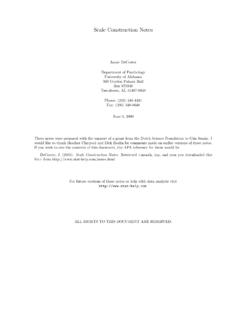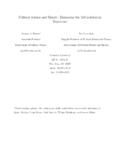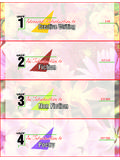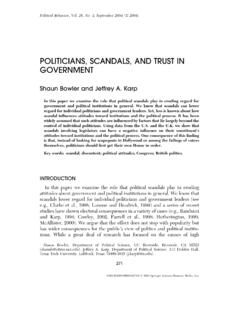Transcription of Writing across the Curriculum - michigan.gov
1 Writing across the Curriculum Click to find: Social Studies Science Mathematics Visual and Applied Arts English Language Arts Introduction: Writing across the Curriculum What is it? Teachers across the disciplines use Writing -to-learn and Writing -to- demonstrate- knowledge Basic Principles of Writing across the Curriculum (WAC) In response to the need of students to learn content using a variety of strategies and their need to practice Writing in a variety of contexts, many teachers have adopted the strategies associated with WAC. The following principles underlie WAC: Writing promotes learning, Integration of Writing and the Writing process promotes student participation, a diversity of student voices, and engage students as critical thinkers while promoting their texts as important resources and thinking tools, Effective Writing instruction integrates disciplines, Opportunities to write in every class develops good writers, Using Writing as part of instruction can be used in every classroom, Only by practicing the thinking and Writing conventions of an academic discipline will students begin to communicate effectively within that discipline.
2 To enhance the learning of students in all disciplines. What's In It For Teachers and Students? Including Writing in instruction has short and long-term benefits. In the short term, students and their teachers are better able to appraise how well they grasp information and where deeper elaboration of key concepts is needed. Students are able to take small pieces of content and analyze it for patterns and connections. In the long run, students who use Writing as a technique to learn content have their skills as thinkers developed. Organization, summary, and analysis of content become easier for students, producing richer understandings. Students become more practiced at using Writing to communicate their learning and thinking. Writing is used to initiate discussion, reinforce content, and model the method of inquiry common to the field.
3 Writing can help students discover new knowledge to sort through previous understandings, draw connections, and uncover new ideas as they write. 2 Writing -to-Learn activities encourage the kind of reflection on learning that improves students metacognitive skills. The key to effectively using Writing activities in every subject lies in matching the right activity to the learning situation. As you select Writing strategies, ask yourself, How well suited is this task for the objective the students are learning? Does this strategy fit my students abilities and needs? Will this strategy complement the way my students will be assessed on the content later? Assigned Writing in all classes and courses helps students keep their Writing skills sharp.
4 Students become better readers, thinkers, and learners in a discipline by processing their ideas through Writing . Writing assigned across the Curriculum also helps students prepare for the day-in and day-out communicative tasks they'll face on the job, no matter what the job is. Equally important, students need to learn how Writing is used within a discipline. Utilizing many different kinds of Writing assignments gives students practice with a variety of disciplinary forms and conventions. So why assign Writing in your classes? Students will learn more content and will leave your classroom better prepared to face thinking and communication challenges: To communicate information, To clarify thinking, To learn new concepts and information, To engage in types of Writing practice that will enhance students future academic and work opportunities.
5 3 Definition: Writing -to-Learn A Writing -to-learn strategy is one that teachers employ throughout and/or at the end of a lesson to engage students and develop big ideas and concepts. Writing -to-learn fosters critical thinking and learning. It is Writing that uses impromptu, short/informal Writing tasks designed by the teacher and included throughout the lesson to help students think through key concepts and ideas. Attention is focused on ideas rather than correctness of style, grammar or spelling. It is less structured than disciplinary Writing . This approach frequently uses journals, logs, micro themes, responses to written or oral questions, summaries, free Writing , notes, and other Writing assignments that align to learning ideas and concepts.
6 4 Definition: Writing -to-Demonstrate-Knowledge A Writing -to- demonstrate- knowledge assignment is one that teachers employ when they assign reports, essays, persuasive Writing letters and papers, and research papers. When Writing to demonstrate knowledge, students show what they have learned by synthesizing information and explaining their understanding of concepts and ideas. Students write for an audience with a specific purpose. Products may apply knowledge in new ways or use academic structures for research and/or formal Writing . Examples include essays that deal with specific questions or problems, letters, projects, and more formal assignments or papers prepared over weeks or over a course. Students adhere to format and style guidelines or standards typical of professional papers, such as reports, article reviews, and research papers.
7 These should be checked before being submitted by the student for correctness of spelling, grammar, and transition word usage. 5 Preface: Writing across the Curriculum Social Studies Writing : An Important Element in Learning Social Studies Teachers of social studies are faced with the task of assisting students in the acquisition of important knowledge, concepts, and skills. The knowledge, concepts, and skills learned in social studies and other classes will ultimately enable students to become responsible and active citizens. Effective instructional strategies are always sought after and Writing strategies can be useful for the teacher of social studies from Kindergarten to Grade 12. Well designed strategies such as the ones demonstrated in this online document, can engage students as critical thinkers who have the ability to integrate knowledge from a variety of topics and disciplines.
8 This online document was created as a sample of Writing across the Curriculum strategies which can be applied to the social studies classroom. They include strategies to assist students in mastering the skills of summarizing, analysis, reflection, and evaluation among others. While these strategies will assist students in becoming better writers, the main focus of these strategies is to assist students in a deeper understanding of social studies. The importance of these strategies is that they promote deep understanding of the knowledge, content, and skills of the social studies discipline being taught. Each strategy includes a quick definition of the strategy and what it does. In addition, each page has instructions on how to implement the strategy and an example of how it could be used in the social studies classroom.
9 This online guide is not exhaustive. Each of the strategies included can be investigated further by interested teachers. All of the Strategies have been researched and found effective. It is our hope that teachers of social studies in grades 3 to 12 will give careful consideration to each of these proven strategies, and add them to their repertoire of effective instructional strategies. 6 Table of Contents: WAC in Social Studies Preface: WAC in Social Studies .. Definitions: Writing -to-Learn .. Writing -to-Demonstrate-Knowledge .. Writing -to-Learn Strategies: Strategy: GIST Generating Interactions between Schemata and Texts .. Strategy: Introducing a Famous Person .. Strategy: Learning Logs .. Strategy: List-Group-Label .. Strategy: Micro-themes Writing Summaries.
10 Strategy: Cornell System - Note taking .. Strategy: QAR - Question-Answer Relationship .. Strategy: Quick Writes .. Strategy: RAFT Role, Audience, Format, and Topic .. Strategy: Reading Response Journal .. Strategy: Skimming and Scanning .. Strategy: Strip Stories - Story Board Graphics .. Strategy: Summarizing .. Strategy: Thinking Maps to Outlines .. Strategy: Word Bank Writing .. Writing to Demonstrate Knowledge: Strategy: Process Writing .. Form/Format: Essay Writing .. pg. 06 pg. 04pg. 05 pg. 09pg. 10pg. 11pg. 13pg. 14pg. 15pg. 16pg. 17pg. 18pg. 22pg. 23pg. 24pg. 25pg. 26pg. 28 pg. 29 pg. 31 7 Form/Format: Persuasive Civic Writing .. Form/Format: Reports.. Form/Format: Research Reports and Papers.. Form/Format: Using Narrative Writing to Demonstrate Knowledge.

















